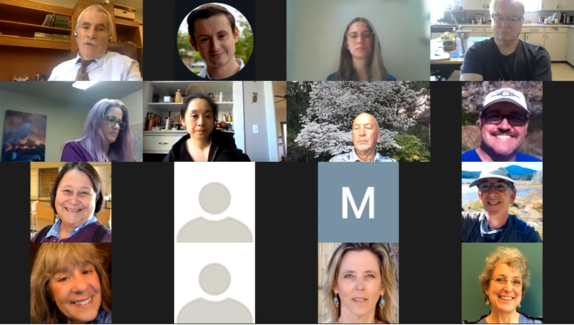 * “I am only one, but still I am one. I cannot do everything, but still I can do something; And because I cannot do everything I will not refuse to do the something that I can do.”
—Helen Keller
 As usual, the spirited conversation at our May Town Hall last week was helpful guidance for me. Thanks to those of you who attended; if you didn’t, the video is here. We’ll do it again on June 1.
I wrote last time about a whole new approach we’re taking—you could call it an experiment—with some of the American Rescue Plan Act (ARPA) dollars headed for Oregon. Every member of the House of Representatives has been allocated $2 million, and every Senator $4 million, for one-time expenditures in their districts. I put out a call for proposals that would build more capacity for good work going on in the Rogue Valley, and got more great suggestions than $4 million could possibly fund.
Monday of this week I submitted my final list to legislative leaders:
- $1.4 million to the Family Nurturing Center for a new facility to expand its collaborative work with Rogue Community Health, Oasis Center and Addiction Recovery.
- $1.3 million to upgrade and fortify the campus of Armadillo Technical Institute, which does great work in tightly limited space adjacent to Phoenix High.
- $1 million to the city of Medford, in partnership with Rogue Retreat, to expand and improve the urban campground that’s offering houseless people along Bear Creek a safe alternative they haven’t had before.
- $300,000 to Rogue Valley Habitat for Humanity to rebuild its ReStore on North Pacific Highway, which provides a major source of ongoing revenue for their important work.
Going through this process reminded me of Southern Oregon’s riches when it comes to volunteer organizations passionately focused on meeting tough and basic challenges. Energizing and amplifying their work with grants like this is a solid investment of taxpayer dollars.
Last week I reported on my Natural Resources Committee’s April 28 hearing that explored charges that the Oregon Department of Transportation’s program to remove fire-killed hazard trees near roadways and buildings had gone off the tracks. We heard testimony from former workers on the project and private landowners that the official process for making sure trees were in fact dead and located in perilous places was being widely ignored.
Two days later, at the beginning of a House hearing with the same focus, ODOT announced that in light of the April 28 testimony, they were hiring an independent investigator for on-the-ground assessment of the charges. That was a good response, and I’m looking forward to hearing what they discover. At the same time there was testimony that continuing debris and hazard tree removal without interruption was critical to maintain the momentum of wildfire recovery, which was slow to get moving in the first place. Later that day, House Wildfire Committee Chairman Brian Clem and I partnered on a letter to the Governor with five suggestions for setting the operation right without bringing it to a halt. No response so far, but my Committee is scheduled to get an update from ODOT this Monday, May 17.
 Photo from ODOT
This conversation is prone to go astray in a couple of ways. I realized one when I saw coverage of our hearings right next to a report that lumber prices have more or less tripled since the September wildfires. I imagine some Oregonians are wondering who could possibly object to cutting any charred trees while Home Depot’s charging almost ten bucks for a 2x4 stud. Without diving into the economics behind these staggering price increases, it’s safe to say that no amount of overcutting in ODOT’s hazard tree project would bring those prices down (though a national investigation into price gouging might).
More generally, this flap can easily slide into the broader, and longer-term, fight over post-fire salvage logging. A couple of bills this session have reflected the view that any burned trees left standing are a waste of valuable material pure and simple, as well as the economic activity they could generate. In April, a panel of career foresters and OSU faculty told my committee that’s not the way things work, but it’s not at all clear that any minds were changed. This debate goes back decades, and it’s a fair one to have. But it needs to be kept separate from the narrower, very specific question of whether ODOT’s hazard tree removal project is following contractual requirements, in part because Oregon could lose massive amounts of FEMA reimbursement dollars if the rules aren’t followed. Beyond that is the small matter of actually doing what we tell Oregonians we’re going to do.
 |
Responding to growing displeasure with the way Oregon’s been measuring the pandemic, and especially the volatility of zigzagging from one risk category to another over the weeks, Governor Brown announced a sizable change this week. Instead of leaning so heavily on new case counts, the pace of re-opening will now depend on vaccination rates. When a county has 65% of its residents 16 and older vaccinated, they can move into the low risk category, much less restrictive than what we’ve seen this past year. Counties that reach 70% can leave the risk level system altogether. There might still be some mask and distancing requirements, but businesses and other organizations will be able to return to otherwise normal operations.
The interactive map at this site will tell you we still have a ways to go. At 38% vaccinated, Jackson County ranks 20th among Oregon’s counties, midway between Benton County’s 56.7% and Umatilla County’s 24.8%.
I’m among Jackson County’s 38%. Like many who write me, I’ve been perplexed by the conflicting online claims about pretty much everything COVID, and I’ve second-guessed Oregon’s course more than a few times. But that’s all against a backdrop of knowing that leadership decisions in this pandemic, with critical gaps in what’s known about the virus, are excruciatingly hard to make and easy to criticize. Few days pass without a conversation with state leaders about what can be done to enable families to gather for large outdoor graduation ceremonies, or businesses to open (and stay open) at larger capacities, or for Shakespeare and Britt to confidently plan a fall season. I’m like everyone I know: ferociously ready to be done with all the restrictions and back to in-person life. This week’s news is that we can probably do that soon if most of us get vaccinated. I’m going to count on that. The link under “COVID Resources” is a path to vaccination appointments. Even if you’re a little skeptical, I hope you’ll use it.
SB 554, has now passed both Chambers and is on the Governor’s desk.
A fair number of the unhappy emails I’ve read blast provisions that simply aren’t in the bill we passed. That probably comes from both the misinformation spread by some groups who organized the email campaign, and the fact that compromises changed the original bill considerably along the way. Here’s a good, clear explanation (not as short as some might like, but a worthwhile read for those who care about the issue) of what the final bill actually does. I can’t say that this document has changed a lot of minds, but some people have said the final version is a big improvement over the first.
A retired legislator I know (from the other party, actually) told me to do everything possible to steer clear of bills on gun safety and abortion—“they’ll bring you nothing but grief.” It’s not so much that I’m ignoring his advice as it is that I haven’t found a way to follow it.
 On a slightly lighter note: what do you think of the idea of giving 16- and 17-year-olds the right to vote in school board elections? That’s what SB 776, currently in the Senate Rules Committee, would do. It scales down a broader proposal, under consideration in other states, to lower the voting age to 16 for all elections. Some see SB 776 as a way to beta-test the larger idea.
The bill gets mixed reviews from my colleagues. Some say that, with notable exceptions, 16-year-olds are too distracted and uninformed to take on this responsibility. Others think this could be a good and effective opportunity for applied civics education. I can imagine a government teacher devoting a few lessons to an upcoming election, complete with research reports or interviews of the candidates, and even debates among students who are voting differently. That could impart a deeper and longer-lasting understanding of the system and the responsibility we hold in it. That’s why I’m co-sponsoring the bill.
People tend to have a fairly strong opinion on this issue. What’s yours?
I hope you had a good Mother’s Day this past week. Talk to you soon...
 Senator Jeff Golden, Oregon Senate District 3

How do I get the COVID-19 vaccine?
- Go to the Jackson County COVID-19 vaccine page to find the nearest vaccination location to you. The Jackson County Expo has a walk-up and drive-up clinic that is free. See the flyers below this section for more information.
- If you would prefer to have assistance scheduling your appointment, the Aging and Disabilities Resource Connection (ADRC) is available to help seniors navigate the process and access the COVID-19 vaccine in Jackson and Josephine Counties. Call ADRC at 541-618-7572.
- Looking for more information? Check out the Oregon Health Authority's COVID-19 page.
|